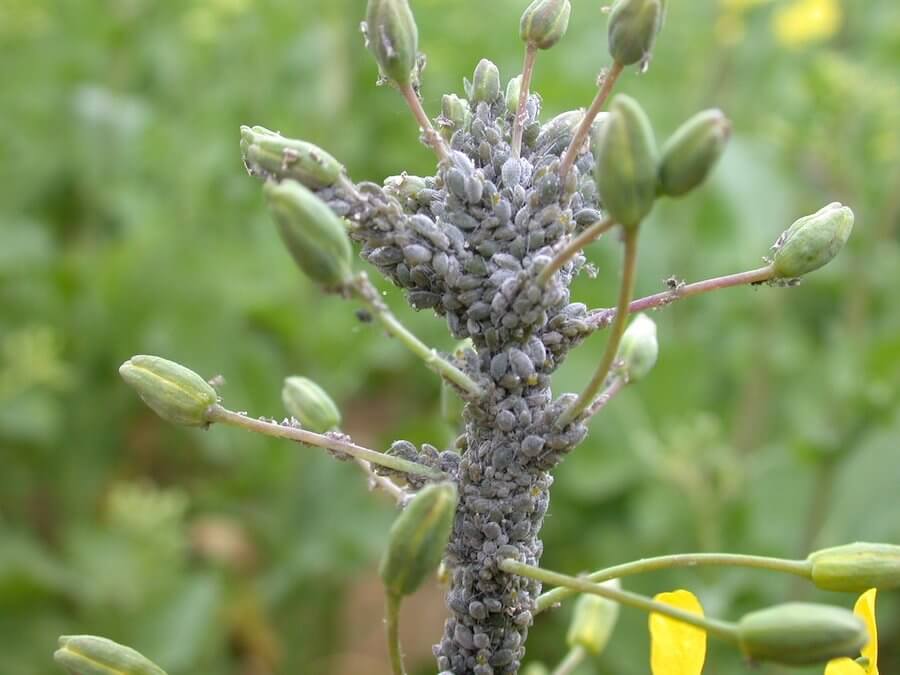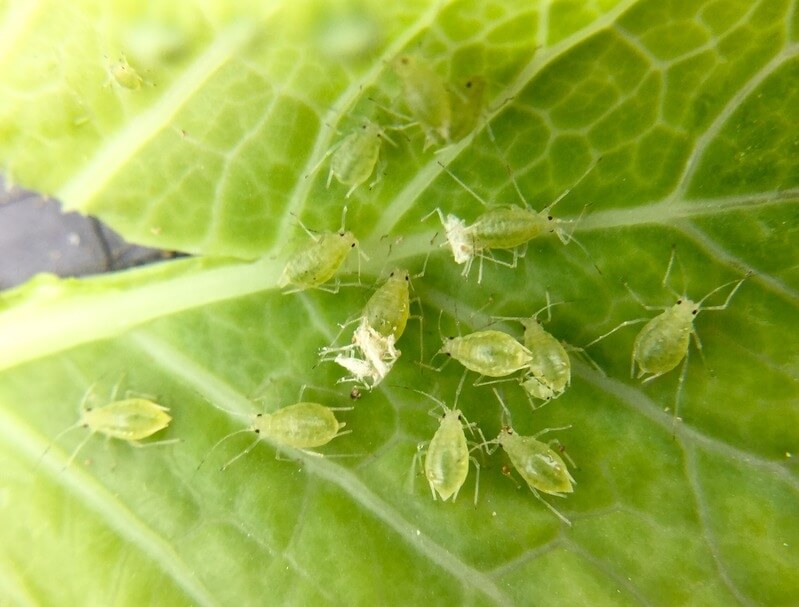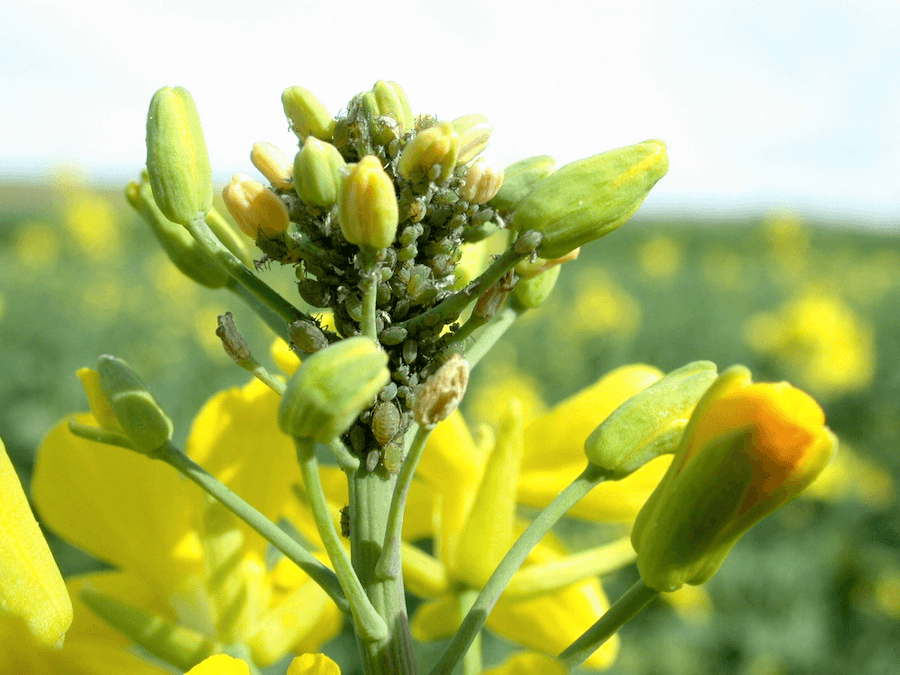Canola Aphids
|
Cabbage aphids. |
Green peach aphids. |
|
Turnip aphids. |
|
Aphids are currently one of the most important pests of winter canola on the High Plains. Three species of aphids can infest the crop, and each has its own phenology, preferred feeding locations, and typical damage symptoms. However, all of them exploit a range of alternative host plants, mostly in the family Cruciferae, which includes many popular garden vegetables (broccoli, cabbage, etc.) but also plants in the families Solanaceae and Cucurbitaceae. Many common weeds such as nightshades and various wild mustards can also serve as hosts. This means there are many local sources of aphids with ability to infest the crop wherever it is grown. In addition to directly damaging plants and reducing yield, the aphids can vector a variety of viral diseases. Crop residues on the soil surface can reduce aphid settling rates, so no-till fields may be less susceptible to aphid colonization in early growth stages. Although insecticidal seed treatments will suppress aphid populations on seedling plants in the fall, most yield is lost by aphids feeding on reproductive stages in spring long after seed treatments have worn off.
Biological control of aphids on canola is not nearly as reliable as it is on most other field crops that have a longer history of cultivation in this region. The reasons are not clear, but many factors likely contribute. Canola is a relatively new crop in Kansas, planted on limited acreage, and thus aphid predators and parasitoids have had little opportunity to evolve crop-specific responses that might render them more effective biological control agents, such as better phenological synchrony with the crop (e.g., earlier colonization, before aphid populations can establish and escape control). In addition, the primary aphid parasitoid on the High Plains, Lysiphlebus testaceipes, is unable to complete development in any of the aphids on canola, despite readily attacking and laying eggs in them. However, the aphids are preyed upon by many generalist predators and another parasitoid, Diaeretiella rapae, can successfully parasitize all three aphid species. It is possible that aphid biocontrol will gradually improve as canola acreage is increased and predators and parasitoids evolve adaptations to better exploit aphid populations as they develop on the crop.
Turnip aphid
Lipaphis erysimi
Turnip aphids are now considered a species complex, and the strain with a preference for mustards is often designated L. pseudobrassicae. These are fairly large, pale yellowish or greenish aphids that feed preferentially on the undersides of lower leaves. The antennae are about half as long as the body, and the cornicles (tailpipes) are shorter than those of the green peach aphid. Although they do not normally overwinter in Kansas, they may survive mild winters by remaining underneath the prostrate leaves of plants in rossette stage, as occurs in Oklahoma. Leaves bearing turnip aphids wilt and curl at the edges, and heavily infested plants can become stunted or die. In the spring, they will move up to feed on flower spikes and ripening seedpods.
Cabbage aphid
Brevicoryne brassicae
Cabbage aphids tend to be a problem during reproductive stages in the spring, when they can form dense colonies on flowers and seedpods. These are very dark aphids that secrete a fine, whitish wax that often forms a film on their bodies and the surface of infested leaves. This wax serves to waterproof the aphids during rain events, and also as a deterrent to some natural enemies, making cabbage aphids a less preferred species for many predators and parasitoids. This species is a Brassica specialist that is able to sequester glucosinolates from its host plants, which accumulate in the hemolymph where they are converted to allyl isothiocyanate, a mustard oil which renders the aphids unpalatable, and even toxic, to many predators. Fortunately, canola is relatively low in glucosinolates, which should increase the aphid’s suitability for predators. Larvae of aphid flies, predatory midges, and hoverflies all appear well adapted to prey on cabbage aphids, whereas they may be relatively unsuitable prey for lacewings and some lady beetle species.
Green peach aphid
Myzus persicae
The green peach aphid is a highly polyphagous species that infests hundreds of different host plants. They are host-alternating aphids, migrating to peach trees in the fall where they produce sexual forms that lay overwintering eggs on the twigs. Their color is variable, ranging from pale green, to yellowish green, to brownish, to even pink or red. The antennae are roughly as long as the body, and the cornicles are quite long with black tips. Like the turnip aphid, they prefer to feed on the undersides of leaves, but they are smaller and form looser, less dense aggregations. Feeding by the green peach aphid can cause leaf drop and stunted plants when terminal growth is suppressed. This aphid is an efficient vector of many viruses, including caulifower mosaic and turnip mosaic virus, and is notorious for being resistant to insecticides, particularly pyrethroids.
Management
Plants in vegetative stages can tolerate quite heavy aphid infestations without permanent injury, provided growing conditions are good and natural biological control is sufficient to ultimately limit aphid population growth. Avoiding or delaying insecticide applications early in the crop will decrease the chances that additional treatments will be required later. Economic thresholds are not well established for aphids in canola, and scouting for aphids requires examining at least 3 plants in each of 7 locations in a 160 acre field. Based on these results, treatment may be justified if 20% of racemes are infested (25-50 or more aphids) from budding to early bloom stages, or 15% in the case of cabbage aphids. Research in Oklahoma suggests that an average of one turnip aphid or one green peach aphid per plant during reproductive stages can translate into .5 pounds per acre of yield loss. Application decisions should be weighed against the expected value of the crop and the cost of treatment. Growers should consult their crop advisors for insecticides labelled for aphid control on canola. Formulations with pymetrozine, flonicamid, or sulfoxaflor as the active ingredient will be more selective and provide better survival of aphid natural enemies than will cheaper, generic materials that function as contact neurotoxins (pyrethroids and organophosphates). An aerial application volume of at least 10 gal per acre is recommended.
Page created by J.P. Michaud, 5/1/2024.


